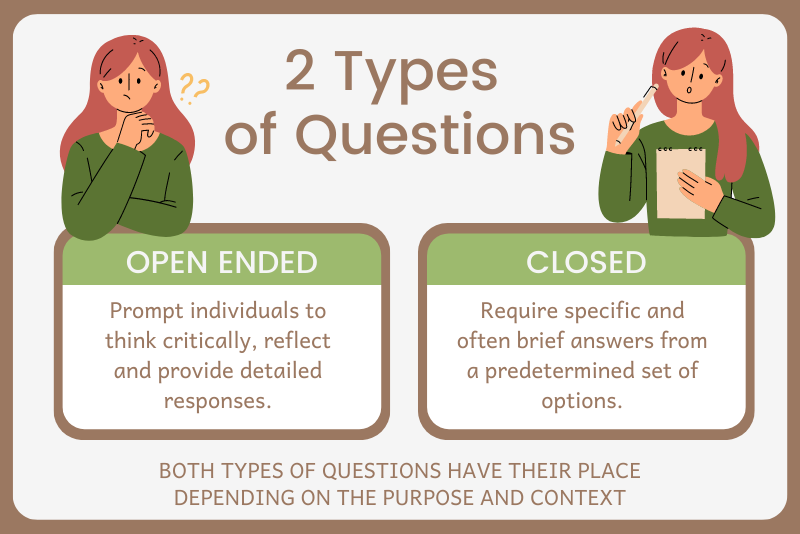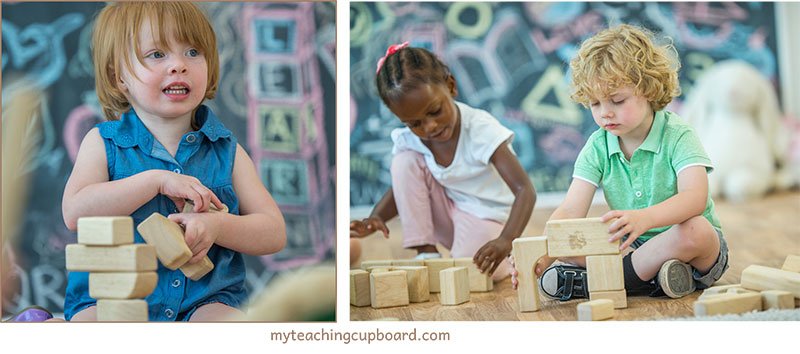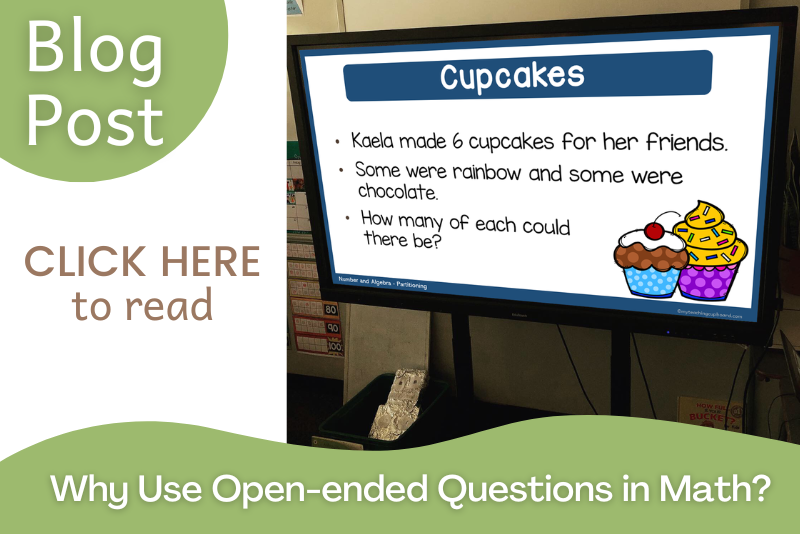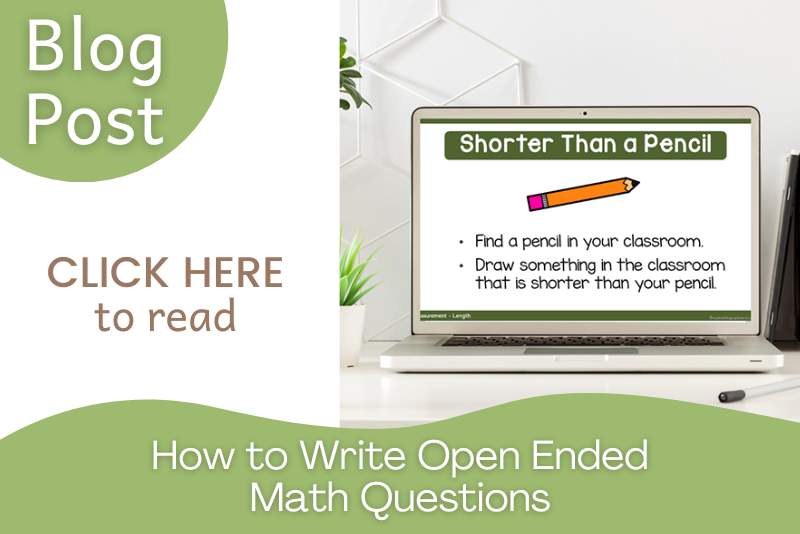Open-ended Questions Promote Higher Order Thinking
Find out how open-ended questions for kids can foster higher order thinking. Discover practical tips, sample questions, and how to use these powerful tools to boost critical thinking and student confidence in your classroom.
As kindergarten teachers, we’ve all been there—watching our students explore a play area or engage in an activity, only to realise that their investigations aren’t going as deep as we’d hoped. You can see they are busy, but are they truly thinking?
Are they asking questions, making connections, and exploring the “why” behind what they’re doing? Sometimes, despite our best efforts, we find that the children’s engagement stays at a surface level, and we’re left wondering how to push them further, how to provoke that spark of deeper thinking.
This is where open-ended questions come in. These questions can transform your classroom interactions and help guide children into richer, more meaningful investigations.
By asking the right questions, we can encourage our students to
develop their language skills
to think critically
to explore new ideas
and to truly engage with the world around them.
But, let’s be honest! When you’re in the thick of it, it’s not always easy to come up with those perfect questions on the spot.
I’ve been there myself. Even with all my years of experience, I’ve sometimes found myself at a loss for the right words during investigation time.
That’s why I began placing printable posters with open-ended questions around my classroom. These prompts have become some of my favourite things in the classroom. They truly are invaluable aids, helping me engage purposefully with my students, and ensuring that every moment of investigation time is an opportunity for deeper learning.
With these questions at my fingertips, I no longer worry about finding the right thing to say because I’m prepared.
Understanding Open-Ended Questions
Open-ended questions are questions that cannot be answered with a simple one-word answer. Instead, they invite children to think, explore, and articulate their thinking.
These types of questions are the best way I have found to promote higher order thinking because they encourage children to go beyond surface-level responses and engage in deeper critical thinking, problem-solving, and creative exploration.
The best thing about these types of questions is that you are providing children with the opportunity to experiment, investigate, and solve problems, which are all key components of higher order thinking.
In my opinion, the best gift you can give any child is the gift of a problem to solve because solving problems is a fundamental aspect of developing higher order thinking skills.
When children are presented with a challenge, an open-ended question can prompt them to think critically about how to approach it, encouraging them to explore different possibilities and come up with their own solutions.
This process not only fosters a deeper understanding of the subject matter but also nurtures their natural curiosity and wonder about the world.
How Open Ended Questions Differ from Close Ended Questions
A closed question, on the other hand, typically has a specific answer or straightforward one word answer—often just a "yes" or "no."
While closed ended questions can be useful in certain situations, they don’t offer the same opportunities for deep thinking and exploration that open-ended questions do. They also don't give you very valuable information on what a child is thinking.
For example, asking a child questions like, “Did you build a tower with the blocks?” limits their responses to simply confirming or denying the action. In contrast, asking, “Why did you decide to build the tower like that?” is a great way to invite them to explain their thought process, reflect on their choices, and potentially even re-evaluate their approach.
The difference lies in the depth of engagement.
Closed-ended questions can sometimes lead to passive participation, while open-ended questions actively engage children in thinking and expressing their ideas.
By choosing to ask open-ended questions, you are encouraging children to think more deeply, to wonder, and to explore the full range of their cognitive abilities.
Open Ended Questions Take Play to a Higher Level
Using open-ended questions is a natural extension of any play-based learning philosophy.
In a play-based classroom, children are encouraged to follow their interests, explore at their own pace, and learn through hands-on experiences.
Open-ended questions play a pivotal role in this environment, as they provoke wonder and encourage children to think more deeply about their play and investigations.
By using divergent questions like open-ended ones, you will be helping your children to articulate their thoughts, consider multiple perspectives, and develop a deeper understanding of the world around them.
Ultimately, the use of open-ended questions is not just about getting children to talk more. It's about developing a classroom that values curiosity, problem-solving, and critical thinking.
One of the greatest gifts you can give children is allowing them the opportunity to solve problems. Solving problems develops higher order thinking skills. Children must be given the opportunity to experiment, investigate and solve problems. If you are lucky, they may even fail!
It's OK to Fail
There must be an acceptance that failure is natural in the learning process. In fact, it is important that you and your students see failures as a springboard to growth and success.
So when you encourage your students to experiment, investigate and solve problems, also encourage failures.
This will ensure you nurture the natural curiosity and wonder children have about the world. As a result, you will be giving them the gift of lifelong learning.
Children naturally learn by first having a sense of wonder or interest in something.
Then they will explore and experiment. They will be discovering various possibilities and reflecting on their observations.
They will experiment, explore, fail and reflect some more.
Consequently, their reflections provoke more interest and wonder and so the cycle continues. Their curiosity leads them to increasingly complex knowledge and sophisticated, higher order thinking.
No Wrong Answers: Boosting Confidence and Self-Esteem
One of the most empowering aspects of open-ended questions is that there is no right or wrong answer.
This means that every child’s response is valued, and they are free to express their own ideas and thoughts without fear of making a mistake or worrying if they have the right answer. This lack of judgment creates a safe space for children to explore their thinking, take risks, and share their perspectives.
When children realise that their answers are not only accepted but encouraged, it can significantly boost their confidence and self-esteem. They learn that their ideas are important and that their thinking process is valued. This sense of validation can be incredibly motivating, encouraging them to participate more actively in discussions and to take ownership of their learning.
By consistently using open-ended questions, you’re not just teaching children to think critically but you’re also helping them develop a positive self-image as capable, confident learners. They learn that it’s okay to explore, make mistakes, and try again, all within an environment that supports their growth and development.
The Role of Open-Ended Questions in Promoting Higher Order Thinking
Why does higher order thinking matter so much?
Higher order thinking is essential for children’s development and long-term academic success. It goes way beyond the traditional memorisation and recall of facts and helps children focus instead on the ability to analyse, evaluate, and create.
These skills are critical because they enable children to apply what they’ve learned in new and meaningful ways and that fosters a deeper understanding of the curriculum and your learning objectives.
In our modern world problem-solving, creativity, and innovation are increasingly valued. Developing higher order thinking skills from an early age can set the foundation for lifelong learning and success.
When children engage in higher order thinking, they become better equipped to tackle complex challenges, think critically about information, and make informed decisions. This not only enhances their academic performance but also prepares them for the demands of the future.
Some Examples of Higher Order Thinking Skills
Higher order thinking involves a range of cognitive skills, including analysis, evaluation, and creation. Here’s how open-ended questions are an excellent way to target each of these skills:
Analysis: When you ask a child to explain how they solved a problem or why they chose a particular approach, you’re encouraging them to break down their thought process and consider the steps they took. For example, asking, “What made you decide to use these materials in your construction?” prompts them to analyse their choices and reasoning.
Evaluation: Open-ended questions can also lead children to assess the effectiveness of their actions or decisions. A question like, “How do you think your tower would change if you used different blocks?” encourages them to evaluate their work and consider alternative strategies.
Creation: Creativity is a key component of higher order thinking, and open-ended questions can inspire children to come up with new ideas or approaches. Asking, “What would happen if you combined these two ideas?” invites them to innovate and explore new possibilities, pushing their thinking beyond the immediate task at hand.
By consistently incorporating open-ended questions that target these skills, you’re not only fostering a deeper level of thinking but also helping children to develop the cognitive abilities that they will need throughout their lives.
Here's a good example:
I remember seeing a breakthrough in some of my student’s thinking because I asked an open-ended question. During investigation time, a group of children were building a bridge with the wooden blocks. They were focused on stacking the blocks, but their structure just kept collapsing.
Instead of telling them how to fix it, I asked, “What do you think would happen if you tried using a different base for your bridge?” This simple question sparked a conversation among the children about stability and balance. They began experimenting with different block arrangements, discussing their observations and testing various ideas.
Eventually, they discovered that using wider blocks as a foundation made their bridge more stable.
But the most remarkable part was not just that they solved the problem—it was the depth of their engagement and the excitement they felt in figuring it out on their own.
This moment of critical thinking and collaboration was sparked by just one single open-ended question.
There is great power in these simple questions.
They really do promote higher order thinking.
This experience reinforced for me the importance of giving children the space to explore, experiment, and think critically. By asking the right questions, we can guide our students to deeper understanding and greater independence in their learning.
Common Challenges and How to Overcome Them
Do you find yourself struggling to come up with just the right questions?
As educators, we all know how crucial it is to ask the right questions, especially when guiding young children through their investigations but, when you're in the thick of a busy classroom, it can be incredibly challenging to think of the perfect open-ended question on the spot.
You might find yourself resorting to simple yes-or-no questions or missing opportunities to push a child’s thinking to the next level. This is a common struggle for many teachers, and it can leave you feeling frustrated, especially when you know the value of deeper, more meaningful interactions during play and investigation time.
This challenge isn’t just about coming up with questions—it’s about ensuring that those questions are effective in promoting higher order thinking - it’s about coming up with the right questions!
The right questions can turn a simple activity into a rich learning experience, while the wrong questions can result in missed opportunities for cognitive growth.
When you're juggling multiple tasks in the classroom, it’s easy to fall back on closed-ended or leading questions that don’t fully engage the child’s thinking.
This is where my printable open-ended question prompts can help you. I’ve designed these prompts specifically to help you overcome the challenge of thinking on your feet.
These cards are not only visually stunning and enhance the overall aesthetics of your learning environment, but they are also practical tools that will help ypu cultivate higher order thinking in your students.
By placing these prompts around your room, you’ll not only create a beautiful, inviting space but also have a ready resource to inspire deeper thinking and inquiry at your fingertips.
Many teachers have shared with me how they’ve printed and displayed these prompts, using them not only as decorative elements but as essential guides they refer to constantly.
Here’s just one review: “Absolutely love this bundle—a number of the posters are permanently displayed in my classroom to provoke a deeper level of thinking and questioning with students. Highly recommend.”
Put an end to scrambling for the right words.
With these prompts, you can confidently scaffold your students thinking and learning. You’ll know that you’re asking the kind of questions that will deepen their thinking and enrich their learning experiences.
They act as gentle reminders, guiding you to ask questions that challenge your students to think critically, explore different possibilities, and articulate their thoughts.
If you’re looking to enhance your classroom engagement and take the pressure off during investigation time, my 30 Open-ended Question Prompts on Nature Photos are the perfect solution.
Each prompt is designed to provoke curiosity and encourage higher-order thinking, making them an essential tool in any play-based learning environment. These cards will not only support your teaching but also add beauty and value to your classroom, complementing your classroom décor.
Use these prompts throughout the day – not just at investigation time so you can ensure that every interaction with your students is an opportunity for deeper learning.
Oh they’re also a fantastic way to help and inform other educators in your room, ensuring that everyone is on the same page when it comes to promoting critical thinking and problem-solving skills.
With these prompts, you’ll feel more confident and prepared, knowing that you have the tools you need to guide your students’ thinking and help them reach their full potential.
How to Use Open-Ended Questions to Promote Higher Order Thinking
Using open-ended questions instead of close-ended questions in your everyday classroom activities is easier than you might think. The key is to make these thought-provoking questions a natural part of your interactions with your children so they seamlessly integrate into various learning experiences.
Here are some practical tips to help you get started:
Be Intentional with Your Timing: Choose moments when children are engaged in hands-on play or exploration to ask open-ended questions. These moments often provide the richest opportunities for deeper thinking.
For example, when a child is building with blocks, you might ask, “What are you thinking about as you place those blocks together?” This question encourages them to articulate their thought process and consider the structure they’re creating.
Encourage Reflection: After an activity or at Reflection time, use open questions to prompt children to reflect on their experiences and provide a more detailed response.
Questions like, “What did you learn from trying that?” or “How would you do it differently next time?” help children to analyse their actions and think critically about what they’ve done.
Incorporate Questions into Routines: Make open-ended questions a regular part of your classroom routines.
For example, during circle time, or at Tuning-in, you can ask, “What do you wonder about today?” or “What are you excited to learn about this week?” This not only sparks curiosity but also sets the tone for a day of exploration and inquiry.
Use Visual Prompts: Displaying open question prompts around the classroom can serve as a constant reminder to engage in deeper conversations. Placing these prompts in key areas like the block corner, maker space, or nature table ensures that you always have a question ready to provoke thought and discussion.
Keep Questions Handy with a Binder Ring: You can tile print my open-ended question prompts and put them on a binder ring, so you have them at hand whenever you’re interacting with the children.
I’ve printed and placed these on a ring for myself, which makes it easy to have them with me as I go about my day. This is especially helpful for starting deep conversations and for ensuring that every moment is an opportunity for deeper thinking.
Adapt Questions to the Child’s Level: Tailor your questions to the developmental level of each child.
Younger children might respond well to simpler questions like, “What do you see?” while older children can handle more complex inquiries like, “What do you think will happen if we try this?”
Open Ended Question Examples for Different Learning Areas
Here are some examples of open-ended questions tailored to specific learning areas:
Block Play: “How do you think we could make this structure stronger?” This question encourages children to think about engineering principles and problem-solving.
Maker Space: “What story does your picture tell?” By asking this, you prompt the child to reflect on their creative choices and the narrative behind their artwork.
Nature Investigations: “What do you notice about the different leaves we collected?” This invites children to observe, compare, and think scientifically about their findings.
Math Activities: “How many different ways can you solve this problem?” This question not only promotes higher order thinking but also encourages flexibility and creativity in mathematical reasoning.
For more insights on using open-ended questions in math, check out my blog post on Why Use Open-Ended Questions in Math.
Story Time: “What do you think the character will do next?” This type of question encourages prediction and inference, key components of higher order thinking in literacy.
For a deeper dive into using open-ended questions across different subjects, you can explore several of my other blog posts.
If you’re particularly interested in enhancing your math instruction with open-ended questions, How to Write Open-Ended Math Questions is a must-read. It offers step-by-step guidance on asking questions that challenge students to think critically about mathematical concepts.
Additionally, if you’re looking for more general strategies to spark creativity and curiosity in your classroom, my blog post on The Power of Open-Ended Questions for Kids provides plenty of inspiration and practical examples.
And if you are working with younger children in the early years, The Best Open-Ended Questions for Preschool Kids is a great resource to help you tailor your questions to the developmental needs of your preschoolers.
By consistently using open-ended questions in these ways, you’ll create a classroom environment that not only fosters higher order thinking but also nurtures curiosity, creativity, and a love of learning in every child.
Addressing Common Questions About Open-Ended Questions
Are Open-Ended Questions Higher Order Thinking?
Open-ended questions are a powerful tool for promoting higher order thinking. Unlike closed-ended questions, which often require a simple factual response, open-ended questions invite students to think more deeply and critically.
These types of questions are good conversation starters and encourage children to analyse, evaluate, and create which are key components of higher order thinking.
For example, consider the difference between asking a child, “What colour is the apple?” versus “Why do you think the apple is red?” The first question is straightforward and only requires the child to observe and state a fact. The second question, however, asks the child to hypothesise and explore the reasons behind what they see and that pushes them to think more critically about their observations.
Open-ended questions naturally lead to discussions that challenge students to explain their reasoning, develop creative thinking by prompting them to consider different perspectives, and help them make connections between ideas. This process of deep thinking is at the heart of higher order thinking, making open-ended questions an essential tool in any classroom that aims to foster cognitive growth and curiosity.
What Questions Promote Higher Order Thinking?
To help you ensure higher order thinking is happening in your classroom, here are some question stems that can be used across various curriculum subjects and learning areas:
Analysis: “What patterns do you notice in…?” or “How are these similar or different?”
Evaluation: “What do you think is the most important part of…?” or “Why do you agree or disagree with this?”
Creation: “How would you design a…?” or “What would happen if you combined these ideas?”
Reflection: “What would you do differently if you tried this again?” or “What did you learn from…?”
Prediction: “What do you think will happen next?” or “How do you think this will change over time?”
Connection: “How does this remind you of something else you’ve seen or done?” or “What other ways could you use this information?”
These question stems are a great starting point. They can be adapted to fit various learning contexts, from math and science to art and literacy, making them useful tools for promoting higher order thinking across your curriculum.
How Do Open-Ended Questions Promote Critical Thinking?
Open-ended questions play a crucial role in promoting critical thinking by encouraging children to explore, hypothesise, and reflect on their experiences.
When you ask an open-ended question, you’re inviting children to go beyond simply recalling information—they must engage in a deeper process of thinking about the “why” and “how” behind their answers.
For example, if you ask, “What do you think will happen if we mix these two colours together?” you’re prompting the child to hypothesise and predict an outcome. This not only encourages them to draw on their existing knowledge of colours but also to consider the cause-and-effect relationship involved in mixing them.
After observing the result, you might follow up with, “Why do you think that happened?” which encourages the child to reflect on their hypothesis and the outcome, further deepening their critical thinking skills.
Open-ended questions also promote critical thinking by allowing children to explore multiple possibilities rather than searching for a single correct answer. This openness helps children develop flexibility in their thinking, as they learn to consider different viewpoints, weigh evidence, and make informed decisions based on their analysis and evaluation.
In conclusion, open-ended questions are at the base of critical thinking because they challenge children to engage in complex cognitive processes that ultimately helps them become more thoughtful, independent learners.
Enhancing Classroom Aesthetics with Question Prompts
When we think about classroom design in early childhood education, we often focus on functionality—making sure that the space is organised, accessible, and conducive to learning. However, aesthetics also play an important role in creating an inviting and inspiring environment for both teachers and students.
My open-ended question prompts are designed with this in mind. Not only are they practical tools for fostering higher-order thinking, but they are also visually appealing printables that can enhance the overall look and feel of your classroom.
These prompts, printed on nature-inspired backgrounds, blend seamlessly into any classroom décor, whether you’re aiming for a minimalist, Reggio-inspired environment or a more colourful, eclectic space.
By placing these beautiful cards around your room you will not only have some valuable teaching tools, but you’ll also be enriching the learning environment with elements that provoke curiosity and invite exploration.
Thoughtfully placed prompts will not only guide your interactions with students but also contribute to a calm, aesthetically pleasing atmosphere. The beauty of these cards lies in their dual purpose: they are both educational and decorative, adding value to your teaching practice while enhancing the visual appeal of your classroom.
I’ve found that these question prompts have also caught the attention of other educators. Another teacher-friend visited my classroom one day and immediately noticed my prompts displayed around the room. She was struck by how they added a sense of intentionality and beauty to each learning area.
After seeing how these prompts not only guided my interactions with the children but also contributed to the overall ambience of the classroom, she asked where she could get a set for herself. And that led me to offer these prompts as a resource for others who wanted to achieve the same blend of functionality and aesthetics in their classrooms.
Using open-ended questions in your teaching practice is one of the most effective ways to foster higher-order thinking in your students.
They push your students beyond simple rote answers and invite them to
Explore
Hypothesise
Reflect
Think critically
If you regularly ask your students open-ended questions, you’ll be not only promoting cognitive development but also nurturing a classroom environment where curiosity and deeper learning thrive.
However, we all know how challenging it can be to come up with the right questions on the spot. That’s where my printable open-ended question prompts come in. Designed to be both beautiful and practical, these prompts ensure that you always have a valuable teaching tool at your fingertips.
Whether displayed around the classroom or kept on a handy binder ring, these prompts will help you engage your students in meaningful conversations, provoke their thinking, and enhance the aesthetics of your learning spaces.
Ready to transform your classroom into a place of deeper learning and curiosity?
Instantly download my printable open-ended question prompts to elevate the learning experiences you offer and enrich academic and social learning by encouraging your children’s natural curiosity. These questions tap into that natural curiosity cycle. They make it easy to create a more thoughtful, engaging classroom environment.
I place these cards around my room to prompt my questioning when I’m interacting with the children. They help me to challenge the children to think for themselves. They are also a great reminder for me to invite the children to share their thinking and their view of the world.
It’s important to me to help my children develop higher order thinking skills and to learn in an interesting and engaging way. Sometimes I add beauty and value to a learning centre by including one or two of these open-ended question photos in the provocation. They assist me and other educators in the room to take the learning to the next level.
One of the most important things is that using these prompts will demonstrate to your children that you believe that they have worthy ideas, that you expect them to think for themselves and that they can contribute in valuable ways. This then results in a sense of autonomy, belonging, and competence within the child and the classroom community.
I have found these open-ended question prompts to be a valuable and effective learning tool.
Click on the picture below to check out my 30 Open-ended Question Photos to foster higher order thinking in your classroom today.




















